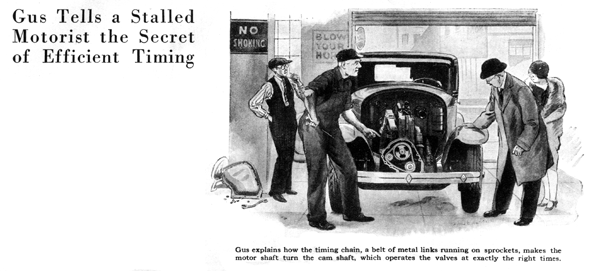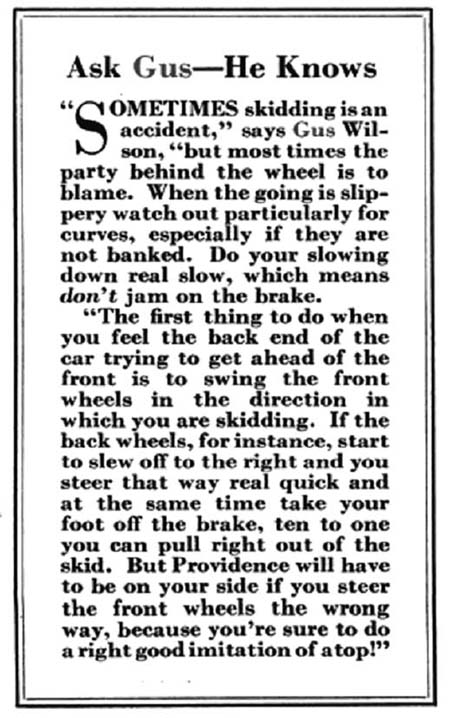May 1929
WHEN VALVES GET OUT OF STEP
By Martin Bunn

"The gas is no good, that's what’s the matter," growled the chubby man disgustedly as he banged down the hood of his car stalled at the side of the road.
"But Theodore," quavered his wife, "the engine was running just a few minutes ago. Why can't you just run it far enough so we can get back to town?"
"That, my dear Elvira, is precisely what I'd like to know how to do. You don't suppose I'm staying here because of the beautiful scenery, do you? We got this bum gas at the Model Garage and by jinks, I'm going to give 'em a ring and make 'em come and tow me in for nothing!"
He stalked off down the road in search of a phone.
Gus Wilson, veteran auto mechanic and half owner of the Model Garage, drove up in the service car a short time afterward.
"Howdy, folks, sorry to see you've had trouble," he called cheerily.
"You ought to be sorry," snapped the car owner. "It's that bum gas you sold me. Motor won't even run on it. Chugs once in a while when I step on the starter, but it hasn't pep enough to keep on going."
"Try again and let me hear how it sounds," Gus suggested.
The starter spun the motor quite vigorously but only an occasional weak explosion followed.
"That's enough" said Gus. Quickly he maneuvered the service car around in front of the stalled automobile and hitched on the towing cable.
"Now," said Gus when they reached the Model Garage, "in the first place there's nothing the matter with the gasoline. We've never sold any bad gas, so that's out. In the second place the trouble is in the motor. And in the third place it's getting late. I'll drive you folks home; and tomorrow, Mr. Van Tine, you can drop around and I'll show you what happened to your motor."
The rotund Mr. Van Tine was waiting when Gus arrived next morning.
"Here's your car," said Gus, "just as we left it last night. To fix what's the matter I've got to take off the radiator, and while I'm doing that I'll explain about it."
"Sure it isn't the gas?" questioned Van Tine, still a trifle skeptical.
"Absolutely," Gus assured him. "The gas had nothing to do with your trouble. This car is several years old and the timing chain is worn out. So are the sprockets. The timing chain, you know, is just a belt made of metal links, and it can wear out same as any other metal part that moves. The timing chain fits around the sprocket on the crankshaft of the motor and the larger sprocket on the cam shaft, so that when the motor shaft turns, the cam shaft operating the valves has to turn, too.
"Of course all cars don't have timing chains. Some use gears to get the same result. What happened on this car was that the timing chain got so loose it began to jump teeth on the sprockets. Every time it jumped a tooth, the timing of the valves got later, until finally the valves were so far out of time that the motor wouldn't run at all."
"You mean the valves don't open to let the gas into the cylinders?" Van Tine questioned.
"Sure they open," Gus asserted. "As long as the cam shaft keeps turning the valves will open and close. But the point is that they open and close at the wrong time."
"No teamwork, eh?"
"Exactly," replied Gus as he removed the timing chain case and exposed chain and sprockets. "See how much play there is" he pointed out, as he wobbled the loose chain back and forth.
"Certainly is loose," Van Tine agreed. "I don't see why it stayed on the sprockets at all."
"Lucky for you it didn't come off," said Gus. "Probably would've jammed and busted through the side of the case. Almost anything might have happened."
"How're you going to fix it?" asked Van Tine.
"That depends on how long you expect to keep the car," Gus answered. "If you plan to sell it or trade it for a new model within a few months, perhaps I can take a link out of the chain. It seems loose enough for that. But if you want a real job the only way is to install a new chain and new sprockets. I could put in a new chain on these old sprockets, but it would wear kind of fast."
"I guess I won't be buying a new car for a while," said Van Tine. "Better make a good job of it and put in the new chain and sprockets. But tell me, how did you know the chain had slipped? I'd like to know how to spot the trouble in case it happens again."
"You've got to know how a gasoline motor works before you can understand valve timing," Gus replied. "Lots of people think that the valve just opens and the gas kind of rushes in of its own free will, the spark plug ignites it, and that's all there is to it. They can't seem to get it through their heads that each piston pushes down on the crankshaft only on every other revolution. The rest of the time it spends pushing out the burned gas, pulling in a new charge, and ramming it into a small space so it'll explode with plenty of pep when the spark occurs."
"Then," Van Tine observed, "if that's the case I can see why the valves have to open and close at the right time. If they didn't, the piston couldn't do those stunts.
"Exactly," said Gus. "When the piston starts down on the intake stroke, the intake valve must be open to let the gas rush in, and so on. When you stepped on the starter last night I could hear a funny hissing noise from the carburetor that told me the intake valve didn't open until the piston was quite a way down in the cylinder and stayed open long after the piston started up again, so that what little charge got in was pushed right out again through the carburetor instead of being compressed."
"Now that you mention it," admitted Van Tine. "I noticed that funny noise, only I couldn't make out what it was, so I didn't pay any attention to it."
"Next time you'll know better," said Gus. "When a motor makes queer noises it's always trying to tell you something is wrong. The chances are it isn't important, but it always pays to investigate anyhow.
"Timing a motor," Gus continued, "would be a tough job if you had to time the valves one at a time. But because all the valves are worked by the cams mounted on a single shaft, you don't have to do it that way. If you get either the exhaust or the intake valve for any cylinder timed right, then all the rest of the valves in the engine are bound to be in time."
"Sounds logical," Van Tine agreed. "Now how do you find out how to time one of the valves?"
"Any good auto mechanic can time the valves so the engine will run pretty well, but you can't do an absolutely accurate job unless you know the auto maker's specifications for timing or unless the flywheel is marked with timing lines."
"Aren't all gasoline motors timed alike?" Van Tine asked. "What's the flywheel got to do with it?"
"They're not alike," replied Gus, "because the valve timing depends on a lot of things, such as the diameter of the valves, the shape of the cams on the cam shaft and how high they lift the valves. In some motors, for instance, the exhaust valve closes just as the piston reaches the top. In others the exhaust valve doesn't close till the crankshaft has gone past top position as much as thirty-two degrees. This happens to be one of the top dead center cars and there's a line cut on the flywheel which tells when you get it in line with the pointer, that the piston is on top dead center. So all we have to do to time this car is to turn the crank till the marks line with each other, find out which piston happens to be at the top, and set the cam shaft so the exhaust valve for that cylinder is just closed, and the job is done."
"How do you find out if the piston is at top center?"
"Easiest way I know, "replied Gus, "is to take out a spark plug and shove a piece of wire into the cylinder so you can feel when the piston gets to the top."
"If I'd done that and checked up the position of the valves when I had one of those spark plugs out last night, I could have located the trouble right away, couldn't I?" suggested Van Tine.
"Put that down in your notebook so you won't forget it?" Gus smiled.
END
